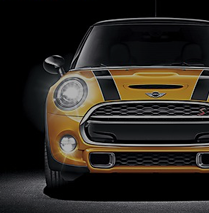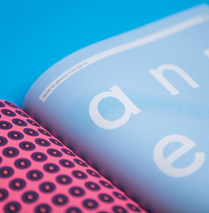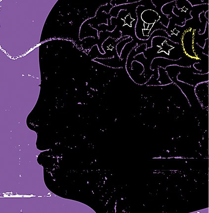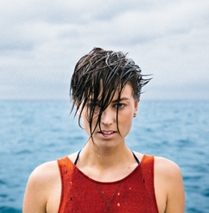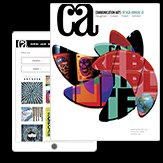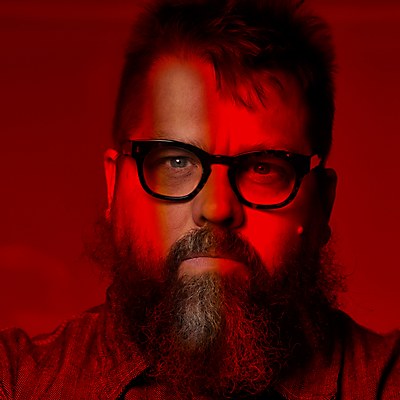How did you discover your passion for design? I vividly remember pretending to be a host on QVC as a kid, using Microsoft Paint to create “screens” for different products I would sell. I’ve always been creative—but the path to professional creativity was not linear. I wasn’t accepted to my university’s graphic design program, so I instead studied in the school of communication, something I’m thankful for. I spent time abroad, then found design jobs at: a commercial real estate company, various agencies and Arizona State University. I’ve designed material for events with Nobel prize winners, and I’ve designed informational brochures for catheters. All this weird and valuable design experience prepared me well for where I’m at now.
What intrigued you about becoming a design educator, and what do you find rewarding about your position as clinical assistant professor of graphic design at University of Illinois Urbana-Champaign? Academia has always been appealing. At Arizona State University, I worked on staff in both the physics and engineering departments. One of the coolest projects I worked on was an event celebrating 100 years of Einstein’s theory of relativity. I had the amazing task of trying to translate this incredibly dense material into something laypeople could understand while still making it graphically interesting. We ended up using a font that was created from Einstein’s handwriting, derived from his various letters and writings.
I’m a curious person, so the academy is where I feel comfortable. Illinois, in particular, feels like home. I was born and raised in the area, so I jumped on the opportunity to teach when a clinical position opened—ideal since I come from an industry background. The transition from full-time designer to full-time educator was seamless, in large part because of help from my colleagues. No question, the most rewarding part of the job is seeing my students reach that “aha” moment—when they get past the moments of discomfort, and everything starts coming together. In every class I teach, my goal is to help students create work they are genuinely proud of. When they do, that’s gratifying.
You also work as a freelance graphic designer and art director. How do you balance your time between teaching and doing freelance work? To answer frankly, I wish I had more time, but designers know well that time is a valuable resource. I freelance mostly in the summer and have the luxury of being picky about which clients I take on. Custom brand identity is my proverbial design bread and butter, so I only do that work now. I’ve found a comfortable niche doing brand work for small, women-owned businesses. I’m also an affiliate of the Siebel Center of Design, which enables me to do creative direction and consulting in collaboration with our students and various companies.
I’ve had to get better about saying no, and I’m still working on it. Alongside time management, I think that’s a valuable skill to nurture as designers.
You mentioned that you think of AI as the La Brea Tar Pits with a similar prey-predator dynamic. What do you think the lure and trap of AI are, and how do you recommend agencies approach it with caution? Don’t get lured by the shiny and exciting new thing. Like the creatures stuck in the La Brea Tar Pits, many are drawn to generative AI’s promises without understanding its complexities. Agencies and designers should approach emerging technology with careful optimism, balancing its potential to enhance creative processes and outcomes while maintaining traditional design methods. It’s like using the same images from Pinterest for moodboarding—if we only rely on generative AI, everything will start to look the same. Be playful, but don’t rely on it too heavily, and don’t abandon foundational tools.
Since we’re watching the rise of generative AI as a creative tool, I imagine that the way you approach design education has shifted. How are you addressing or using AI with your design students? It’s the same thing I tell my kids—everything in moderation. I have encouraged and demonstrated the use of generative AI within the creative process to help produce unique and novel work. We experiment with this in the advanced typography class I teach, which explores graphic design in filmmaking. I used ChatGPT to write scripts for my students; then, they had to create title screens, posters and props for their hypothetical movies. Some students used ChatGPT to generate taglines for their films or learn about the period or region that their movie was filmed in. Some used it to brainstorm cast ideas. Adobe Firefly was utilized to generate images of aliens or medieval castles—neither of which we had access to photograph in our studios, believe it or not.
To balance this AI-driven research, we did a lot of physical research around campus. We went to the rare book and manuscript library to see vintage props, including Bath-o-Sub designs from the James Bond film Diamonds are Forever. We visited the design and architecture library to get hands-on practice in aging documents using coffee and tea as well as playing with various wax molds. We visited the maps library (yes, our university has a library only for maps) to gather inspiration, as many were tasked with imagining and mapping completely new worlds.
Balance is key when integrating generative AI into design workflows. Use it! But don’t become overreliant.
Reading your recent article “Developing Flexible Systems of Cohesive Curriculum” with your colleague Isabel Bo-Linn, professor at Portland State University, you discuss how you’ve adapted your capstone program to respond to the needs of students and faculty members alike. What are some of the issues in design education you feel like need to be addressed with a more flexible approach? Instructors should be willing to share knowledge and adapt. The first time I taught capstone, there were five instructors teaching 80-plus seniors, so it was important for our students to have similar experiences no matter which section they were in. Isabel and I quickly realized that, ideally, curriculum would be cohesive (students could expect similar deliverables and learning outcomes) while being flexible (faculty could incorporate their own research interests and experiences through exercises, discussions or lectures).
This system was hugely successful and helped to build community for both students and faculty. Students engaged in meaningful work on a similar schedule with the same expected deliverables, bringing program-wide structure to a self-guided course. Faculty were also able to share insights from their own classes in real time. What worked or didn’t work? What adjustments need to be made?
When faculty aren’t siloed, I genuinely believe everyone benefits.
What have been some of your favorite projects you’ve designed that have changed your perception of what graphic design can achieve? My perspective has shifted since becoming an instructor. While I’m proud of my own work, I’m even prouder of my students’ work. One of the courses I find most rewarding and challenging to teach is Introduction to Graphic Design. This foundational class equips graphic design major students with the knowledge and confidence to succeed in the program. For non-major students, it broadens their understanding of what graphic design is—and where it is (answer: everywhere).
What continually surprises and inspires me is the curiosity these students bring. Their fresh perspectives remind me that graphic design is not just about style, but about solving problems and communicating ideas in impactful ways. I firmly believe that non-designers could benefit from graphic design education, especially those in the sciences who must communicate complex information visually. An NPR story I love explores this idea.
Graphic designers are hugely important, especially when you think about how critical design is to your everyday life—from highway signs to prescription bottles to fire exit maps. The book Can Graphic Design Save Your Life? is a favorite of mine, constantly affirming that the answer to that question is yes.
Where do you feel the field of design is going, and what excites you about it? Uncertainty seems to abound right now. Many of my students—and their parents—share anxieties about whether “the robots” are going to steal every design job. I always answer with a resounding “no,” and that’s because design is a process, not just a result. We teach the significance of that process and help students understand that design must be intentional and meaningful. We are not just creating things that look nice! Despite what sometimes feels like an unpredictable future, I am steadfast in my belief that design will continue to flourish as long as we prioritize human empathy and creativity.
Do you have any advice for designers entering the profession today? Always do self-initiated work. I often hear this advice from industry professionals that visit campus, too. Not only does this show a certain creative ambition, but it’s a great way to add work to your book if you’re interested in a particular specialty, industry or style.
Doing self-initiated work also keeps your creative muscles lean because you likely won’t find the dream job after graduation. You’ll probably be doing production work, maybe creating boring (but important) diagrams of medical devices. That’s normal, and that’s OK. Don’t get discouraged because not everything you make is portfolio worthy. ca


